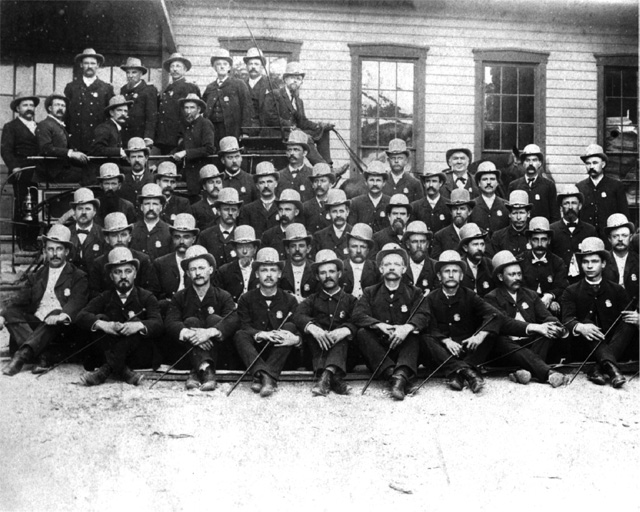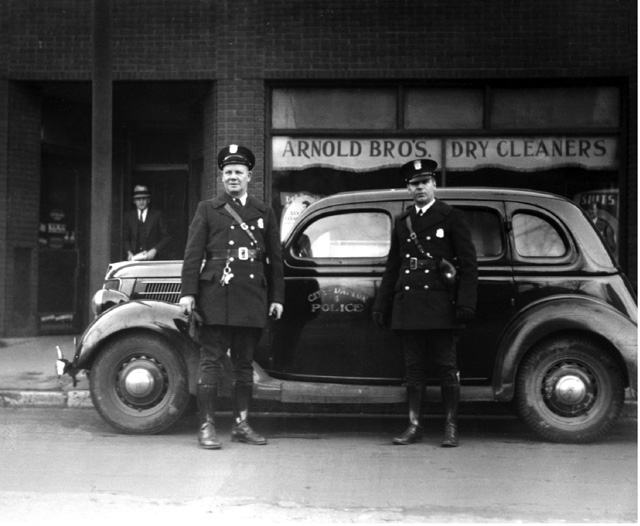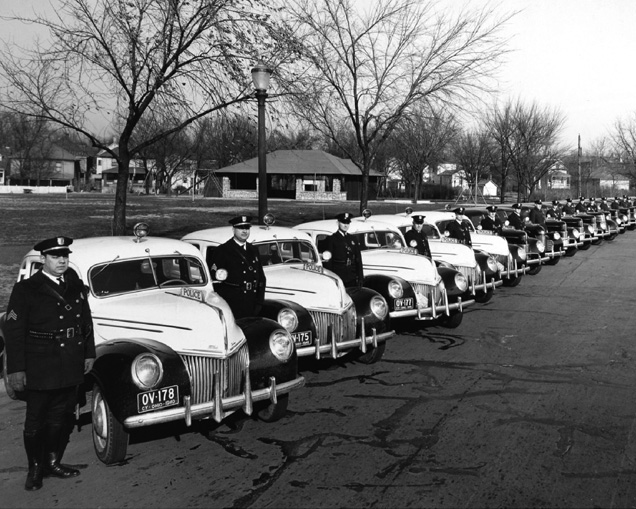The Original Method of Policing: Foot Patrol (1797-1913)
In 1796, seven years before Ohio statehood, the pioneer community of Dayton was settled at the confluence of the Great Miami and Mad Rivers. A year later on June 10, 1797, the foundation of Dayton police service began with the appointment of Cyrus Osborn as its constable. A single constable remained the sole law enforcement authority for the town of Dayton and the role was fairly one dimensional. In 1805, James Miller was appointed the first town marshal. What Marshal Miller found to be a common police responsibility was dealing with violations of hogs running at large.
A man by the name of Joseph Allen was privately contracted in 1833 to be a watchman patrolling a designated “square” in proximity to the courthouse. This was, in actuality, the first walking patrol beat in the town of Dayton. By 1838, the mayor was authorized by town council to appoint up to 10 privately-paid watchmen. Dayton had a population of 6,067 in 1840 and yet a single town marshal was the entirety of the “force”, assisted by watchmen and citizens when called upon; however, the city council provided for the election of two constables to assist the marshal.
Dayton had an “epidemic” of burglaries in 1854. Policing took on a new dimension the following year when city council was urged by the citizenry to address this outbreak of criminal activity. It did so when it appointed 100 men, essentially as a specialized force of temporary law enforcement officers, to restore public safety.
Even as Dayton grew into the 45th largest city in the nation in 1860 with a population of 20,081, only a marshal, a deputy marshal and two constables safeguarded its citizens. The first metropolitan police force in the country was in New York City 15 years earlier in 1845. The trend for the formation of police departments in large urban centers was moving westward into Ohio and, of course, to Dayton.
In 1867 Dayton established a metropolitan police force but, in less than a year with the repeal of state law, the city was forced to return to the old marshal form of policing. Five years later, the Ohio General Assembly passed a law creating a Board of Police Commissioners, placing into effect what had previously been dissolved. What is now the Dayton Police Department was established on May 29, 1873. Dayton, Ohio was the U.S.’s 44th largest city and would remain a top-40s city in the nation for the next 100 years until 1970.

Dayton Police Force of 1888 is comprised of walking patrol officers.
Over the previous 40 years, foot patrol had been the primary means for maintaining public order and enforcing law. Although the police force would have two detectives at the turn of the century to conduct follow-up investigations and to track fugitives, the fundamental method of policing for the next 40 years would remain unchanged and still one dimensional… patrolmen walking their beat.
Dayton’s bicycle shop owners, the Wright Brothers, invented the world’s first flying machine in 1903 and yet local patrolmen were still walking their beats 12 or more hours each day with only one day off every two weeks. Ten years later, Henry Ford developed the modern auto assembly line and the popularity of motor cars would soar, further popularized by an invention by Dayton’s Charles Kettering: the electric self starter. Over decades to come, police foot patrol would diminish. 1913 was also the year in which the Great Flood overwhelmed the community - including police capabilities to manage the human crisis - and the military was called in with the declaration of martial law.
The Creation of Special Details and Crime Squads (1916-1966)
As the 1910s wound down, the Dayton police force had modernized with a vehicle fleet of two “emergency cars” and a few motorcycles. In fact, Ptl. John Stapleton was killed when the motorcycle he was operating collided with a fire truck in 1916. Patrol was changing but so was society. The police department had to find ways to address issues that could no longer be resolved by foot patrol. Specialized police units known as “details” were being formed to handle traffic, crimes and public ruin related to vice activities.
In the early 1900s as in the previous century, the consumption of alcohol was five times what it is today. In 1916, the Dayton police force established a “special bootlegging detail” to address the alcohol problem. Ptl. Charles Thomas was shot and killed while chasing a bootlegger on foot. By 1920 the 90-year-engaged temperance movement finally found success. A constitutional prohibition of alcohol was enacted and with that came changes to law enforcement. In 1921 Dayton police created a “special liquor squad” charged with enforcing the federal liquor prohibition. Police duties were especially focused on “the enforcement of the gambling laws, the midnight closing law, and bootlegging.…” Sergeants were required to make monthly reports “of all conditions covering vice, gambling, bootlegging and disorderly houses… existing in their district.”

Foot Patrol eventually ends with the emergence of motor cars.
Other crimes such as burglary and robbery were also targeted by special enforcement units. In 1923 Dayton Ptl. George Clark was on a special burglary detail and was shot dead when he stopped a suspicious individual to question him. When the stock market collapsed in 1929, bank hold-ups became a wide-spread concern. In 1930 local financial institutions presented Dayton’s Division of Police with a customized “bullet-proof”, heavily armed Cadillac to respond to robbery alarms. As a result, the “Bank Flyer” with its “Flying Squadron” emerged as a unique specialized unit.
Unlike previous details, the ‘Flying Squadron’ was an auxiliary, on-call assignment for its members as it is for today’s HNT and SWAT; the squadron was not full-time duty. This was likely Dayton’s first such police team although its effectiveness is uncertain. Dayton officers managed to arrest John Dillinger in 1933 without the ‘Bank Flyer’. And George ‘Bugs’ Moran evaded Dayton authorities after a local $10,000 robbery, although captured days later by the FBI, returned to Dayton and convicted in 1947 for the crime. The ‘Bank Flyer’ may have merely served as a law and order facade. The aging Cadillac was placed in closed storage by the early 1950s.

Nation’s 1st Police Department with fleet of two-way radio cars.
The Dayton police force prides itself at being at the forefront of change. When President Franklin Roosevelt came to Dayton in 1940, its entire patrol car fleet was outfitted with two-way radio transmitters, the first in the nation. But at times, the forces of society have driven the police to change. The Univis labor strike of 1948, alleged to be one of our nation's more violent labor disturbances, caught the Dayton police under equipped and undermanned. The Univis Lens Co. was an industrial plant in north Dayton whose laborers were joined by union workers from the Frigidaire and Delco factories in what Time Magazine called the “savage three-month strike.”
The Ohio National Guard had to be called in to handle a “mob” numbering by some accounts up to 10,000, just as it would 18 years later when another huge disturbance occurred in west Dayton. These events and others were pushing the Dayton Police Department to move toward a vanguard of change by fashioning teams with crisis intervention expertise.
Return to "Dayton Hostage Negotiation Team" Home Page